|

 Up
Up 
 Kitty Hawk
Kitty Hawk
In A Box

(You are here.)
 Down
Down




  Need
to Need
to
find your
bearings?
Try
these
navigation aids:
If
this is your first
visit, please stop by:
Something
to share?
Please:



|
|
Available in Française, Español, Português, Deutsch, Россию,
中文,
日本, and others.
 ack in Dayton, Wilbur received an invitation from
Octave Chanute to address the
Western Society of Engineers. This was a great honor and a tacit recognition of the value
of the Wright brother’s experiments. Wilbur was inclined to politely refuse, but
Katharine hounded him into accepting. ack in Dayton, Wilbur received an invitation from
Octave Chanute to address the
Western Society of Engineers. This was a great honor and a tacit recognition of the value
of the Wright brother’s experiments. Wilbur was inclined to politely refuse, but
Katharine hounded him into accepting.
Chanute’s kindness and
Katharine’s
persistence put Wilbur and Orville back on track. To prepare his speech, Wilbur had to
carefully think through the results of his and Orville’s 1900 and 1901 experiments.
Because their machines did not produce the expected lift, the brothers had begun to
suspect that the data produced by
Otto Lilienthal -- which every other scientist in the field
took for granted – were incorrect. The more they discussed it, the more convinced they
became. Wilbur decided to stick his neck out and say so in his speech.
To his relief, the speech – which Wilbur simply called "Some
Aeronautical Experiments" – was well received and a copy was published in the prestigious
Journal of the Western Society of Engineers. But now that the brothers had declared
the late, great Lilienthal wrong, what data should be used to replace his tables of lift
and drag? The brothers decided they would have to produce their own tables. While at Kitty
Hawk,
George Spratt had suggested an apparatus that balanced lift against drag to measure
both these quantities more accurately, and now they set about designing it. First they
built a balance from a bicycle wheel mounted so it revolved horizontally. To its rim, they
attached a flat plate and a curved plate 90 degrees apart. In a steady wind, the curved
plate – a miniature wing – could be set at an angle to the air stream so that the
lift generated by air rushing over its surface would be balanced again the drag on the
flat plate set perpendicular to the wind. If the lift and the drag were equal, the wheel
would not revolve. Wilbur and Orville set the curved plate at the angle predicted by the
Lilienthal tables, mounted the wheel to one of their bicycles, and pedaled like mad. As
the air rushed over the plates, the wheel turned. Something was indeed amiss with either
the data or the method that Lilienthal used to predict lift and drag.
Although ingenious, the bicycle apparatus was too crude (and too exhausting) to make
accurate measurements. So the brothers built a wind tunnel from an old grinder and scraps
of wood, and made delicate balances from hacksaw blades and bits of wire. They tested a
variety of wing shapes in the tunnel and by mid-December 1901, they had made a surprising
discovery. Lilienthal’s tables were, by and large, correct! But another number in the
equation he used to calculate lift, the coefficient of air pressure, was way off
the mark. This number had been developed in the mid-eighteenth century by an English
engineer, John Smeaton, to design more efficient windmills. It had been in general use for
nearly a century and a half, long enough to be accepted as gospel.
Wilbur and Orville also found that the shape of Lilienthal’s wings
–
the camber - was inefficient. The curves of the German’s wing were sections of
a circle. The highest point was in the center of the chord, midway between the leading and
trailing edges. Wilbur and Orville found that a wing produced much more lift if its curve
followed the shape of a parabola, with the high point about one quarter of the chord
behind the leading edge.
This was the turning point. The wind tunnel experiments were the brother’s first
venture into pure aeronautical science. It was tedious and time-consuming work, testing
one miniature wing shape after another at 45 different angles to the air stream in the
tunnel. It disproved their original assumption
– that the Lilienthal’s data
tables were wrong – but it pointed the way to the real problem and produced the
knowledge that enabled the Wright brothers to build an aircraft with enough lift to
support their weight in the air. This freed them to concentrate on the original problem
they had set out to solve – control. |
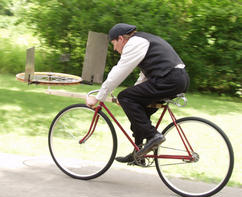
Will and Orv conducted their initial air
foil tests with a strange apparatus mounted to the front of a bicycle.
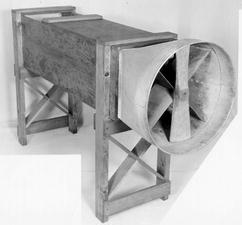
To make more precise tests, they built a wind
tunnel.
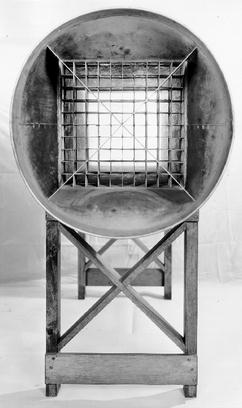
The tunnel had a scoop with two sets of "straighteners"
to provide a smooth air flow.
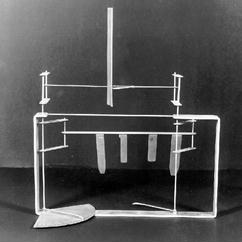
They also devised a lift balance...
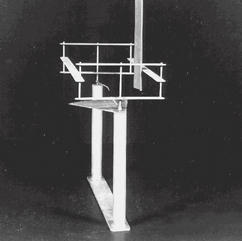
...and a drag balance to test the characteristics of
over 200 miniature air foils.
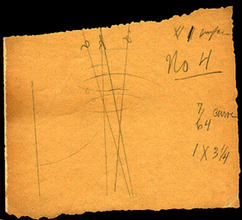
They recorded the results of the wind tunnel tests
on scraps of wall paper.
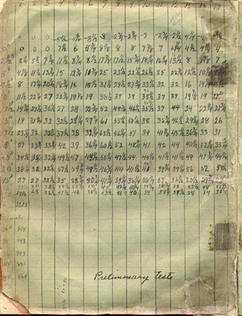
Then they painstakingly compiled them in notebooks
so they could compare the air foils |